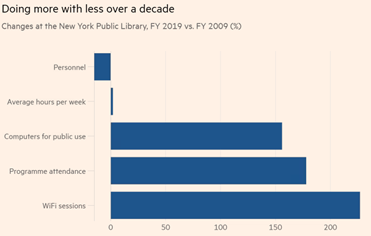
Anna Curtis is a Customer Success Manager based in Michigan. Prior to joining collectionHQ, she worked in public libraries for more than 10 years as a collection development librarian and director.
Library Engagement Increasing
If you asked me to provide one key takeaway from my decade spent working in public libraries, it would be that innovation is vital to keeping communities engaged. This really came to light during the recent pandemic where librarians adapted services to reach their communities despite lockdown periods and other Covid-related restrictions. That connection continues to grow as patrons worldwide are returning in person to their local libraries.
Libraries in the U.S. face a challenge to regain visitors, but over time they have been seeing higher program attendance and an increase in the number of registered borrowers, according to WordsRated, an international research data and analytics group, which analyzed data from 1992 to 2019 from nearly 17,500 libraries from all 50 states. In Great Britain, the number of library visits between March 2021 and March 2022, rose 68% to 1,536 per 1,000 people, up from 915 per 1,000 people during the previous year, according to the Chartered Institute of Public Finance & Accountancy (CIPFA). The number of books borrowed rose 58 percent to 1,767 books per 1,000 people, up from 1,1190 books. Australia’s State Library Victoria recently welcomed a record-breaking number of visitors – nearly 2.1 million visitors during a 12-month period. In May, the library saw more than 9,000 daily visits – a visitor record – on two separate days.
Visits are not only increasing, however. Patron needs also are changing, creating new demands for library personnel. In addition to curating and maintaining collections, for example, some librarians are finding themselves acting more as caretakers of their communities’ health and physical wellbeing, such as by helping people access government services for safe housing or health services. Some libraries are providing space so children can have a hot, nutritious meal.
Library Funding
All of this is occurring as budgets remain uncertain, with some systems seeing funding increased, while others face cuts. Library Journals’s 2022 Budgets and Funding Survey found 2022 budgets were up overall by 6.1 percent from the previous year, pushing the average total operating budget to $8,441,800, up from $7,953,400, representing the largest year-over-year increase since 2013. The survey received 257 responses.
Yet, on the flip side, other systems are poised to see cuts, such as the New York Public Library, which faces a $13.6 million cut in its current fiscal year funding, plus an additional $20.5 million cut for each of the next three fiscal years, according to a program proposed by New York City Mayor Eric Adams.
In the U.K., libraries face a paradox, according to CIPFA. CIPFA reports library visits were up 68% and the number of books borrowed were up 58% during the 12 months ending in March 2022, while total spending continued to fall.
Faced with more demands and possibly fewer resources, how can libraries best adapt to staffing and resource challenges post-pandemic?
One key lies in leveraging library technology to better understand where a collection is succeeding and where changes could improve outcomes. Technology-driven solutions also can help libraries highlight successes and make the best case for increased funding to stakeholders.
Quality Data Can Support Increased Budgets
When negotiating for funding, two key metrics that are good to have on hand are turnover and Dead on Arrival (DOA). These can be excellent data points demonstrating that the library is fiscally responsible with taxpayer money.
Turnover, which shows circulations by the number of items in your collection, can be useful to illustrate how wisely you are spending the money you’ve been given. I like analyzing DOA because it can give a comprehensive picture of a collection’s overall health.
A higher DOA highlights areas of the collection that could use adjusting. collectionHQ helps to assign a dollar amount to new material that is not circulating. Understanding DOA, one of the metrics exclusive to collectionHQ, can shed light as to why specific material isn’t circulating.
Turnover and DOA are also useful in identifying librarian bias in collection development. It is important to maintain balance in a collection, and library systems may not be aware of biases that exist in the selection process. An analysis of this data can help systems put policies in place to counteract any biases. When I worked as Library Director of a smaller, rural system in the Midwestern United States, I looked at turnover and DOA to ensure the material selected both satisfied our patrons’ interests and represented appropriately diverse content.
collectionHQ’s software also helps libraries make better use of items currently in their collection by identifying materials that are overstocked or dead at one library and replacing missing or worn counterparts at another branch. By suggesting books for transfer based on analysis of real-time data, collectionHQ saves systems from having to buy new materials.
More Insight with Less Time
While having data is important, it’s not enough to simply acquire statistics. The data must be analyzed and understood to provide the best value.
Increasingly, libraries are being asked to provide services similar to those provided by social workers, such as helping people find safe places to sleep or access government services. Some libraries are fortunate to have the resources to hire degreed social workers, but many do not, and they are having to navigate those roles themselves while also managing collections and performing other librarian work.
The chart below illustrates this imbalance of increased demands and reduced staffing and staff hours worked per week as seen at the New York Public Library.
Source: Financial Times
Most of the librarians I speak with have limited time, which when you add in the growing list of demands placed upon them, makes it challenging to devote the energy needed to pour through data to find patterns and create solutions.
I have found that librarians appreciate having a plan that transforms integrated library system (ILS) data into easy-to-use answers. collectionHQ, for example, specializes in crunching ILS data and creating action plans that clearly point library staff to specific areas of their collection that need attention. collectionHQ also offers Schedule Management, a tool that helps library management integrate these action plans into a consistent collection management workflow where library staff know exactly what tasks are due and when.
I often act as a sounding board for library staff. I enjoy talking with people and helping them understand their collection more deeply and discussing how they can implement solutions offered via collectionHQ reports. If someone is unsure of how to move forward, for example, I am available to offer unbiased advice based on what the data shows.
Monitoring Change
In addition to assessing collection performance, it is important to keep track of patron needs, which are constantly evolving. For example, as this blog explains, patrons in 2021 became more interested in finding ways of dealing with stress, with interest growing for Health/Fitness and Mental Health titles, and subjects such as pilates and stretching becoming popular. Last year, young readers were interested in material that helped them explore and discover animals and plants. Youth activism has been trending with the advent of social media, as has interest in titles touching on environmental awareness.
There are a variety of tools available that can help libraries monitor reading trends. When I worked in collection development, I referred to Kirkus Reviews, New York Times best sellers, and books selected by national book clubs, such as Reese’s Book Club. I knew I would need those popular titles in my collection.
Shelf space also was an important consideration as I often did not have room for all the titles I would have liked to have. collectionHQ can assist libraries with this as well by easily and efficiently weeding out titles to create space for more current content. For example, I used the DOA report to find titles I had been ordering that weren’t circulating to create more shelf space.
Technology Supports People
The post-pandemic library world remains challenging. Industry-wide, public libraries are seeing changes in staffing numbers and staffing responsibilities. In addition, staff must work to understand how patrons are using the library as a community space.
Through my conversations with librarians, I often hear stories of staffers being pulled in different directions and of their desire to focus more on collection development, which sits at the heart of the library. It is the library staff that knows their community, and it is the people on the ground who are the best positioned to make their library succeed. Library software such as collectionHQ can support busy staff and help them navigate this ever-changing landscape. The right data can help librarians show stakeholders they are efficiently spending tax dollars, and it can help them make their case for continued, or increased, funding and resources.
